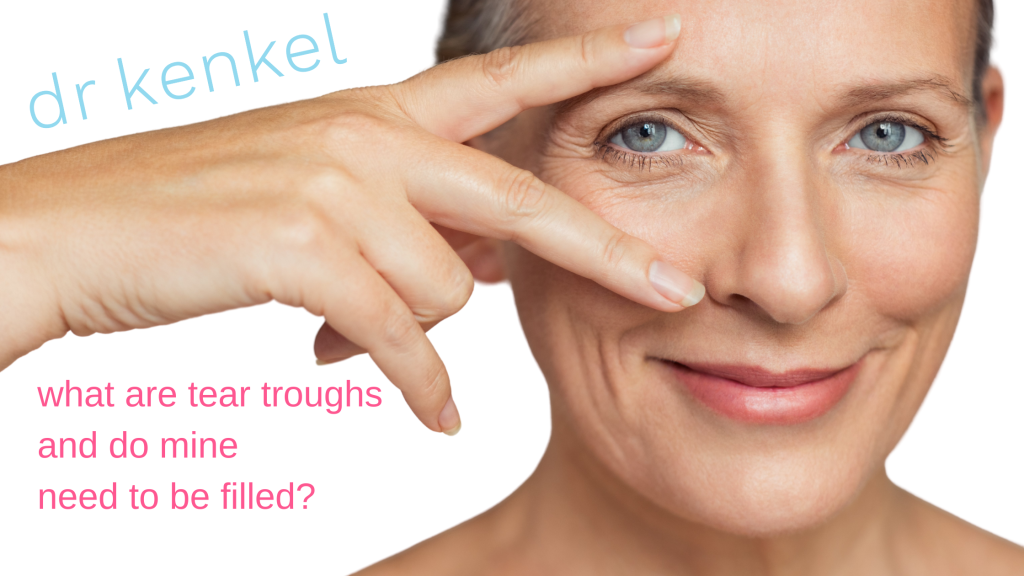The tear trough is a groove that sits close to the nose between the lower eyelid and cheek. On occasion this may begin to show in young people in their 20s. Most of the time, it becomes more evident as we get older, and our face undergoes “aging changes”. This commonly includes loss of volume (fat) in the central cheek and more prominence of our eyelid “fat bags”. It can also be associated with more significant weight loss.
The combination of bulging eyelid fat and loss of fat in our cheeks makes many of us look tired and older than we feel. While tear troughs are a common symptom of aging, we offer various dermal fillers to help address tear troughs and rejuvenate other sunken facial features. Keep reading for answers to popular queries about tear trough filler treatment, and view our before and after photos featuring real patient results.
Why Do Tear Troughs Develop?
Why are my lower lids protruding fat? We are fortunate to have protective fat around our eyes. However, as we age, the membrane that supports the fat becomes weakened, which may result in unsightly bulging.
Why am I losing fat in my face? This is the balance of nature. Most of us try to lose fat regularly—losing a bit in the waist or hips is never an issue. It deflates and ages our appearance when we lose it in our face. The collapse of cheek contours due to volume loss also typically happens with gravity, creating other concerns, such as deeper nasolabial folds (laugh lines), marionette lines, and even a distorted jawline. The loss of fat in the central cheek region exposes the underlying bone in the cheek or malar area and along our eye socket (orbital rim), creating unwanted aesthetic consequences.
What Is Tear Trough Filler?
Injectable fillers temporarily reverse some of the signs of aging described above, including dark, sunken tear troughs. An artfully placed under eye filler softens the transition between the lower lid and cheek, restoring a more youthful appearance. This helps camouflage puffy eyelids and restores projection to our cheeks. If your aesthetic preferences change, our hyaluronic acid (HA) fillers are entirely reversible.
What is the best tear trough filler? We primarily use one of two products: Restylane-L®, Restylane® Refyne, and JUVÉDERM® Vollure. My recommendation typically depends on your skin tone and specific aesthetic goals. Tear trough filler results typically last between 9 to 12 months.
Does under eye filler hurt? Treatment isn’t considered painful, but to enhance your comfort, our team uses a topical anesthetic as well as ice to treat the tear trough. We use a cannula, which is a blunted small probe instead of a needle, which we feel is more precise and less likely to cause tear trough filler bruising. I allow most patients to work out and get back to their normal routine within 4 hours. You can expect some mild swelling that usually resolves within 24 hours. Because there is a local anesthetic in the filler product, one may experience some “twitching” of the muscles in the area for an hour or so.
Is the procedure different in men? Men often lose more volume in the cheek region, so at times, they may require a bit more product in the cheek and along the bone socket (orbital rim). Treatment is never one-size-fits-all. We assess your unique needs and administer treatment that prioritizes your safety and results.
Is filler in the tear trough dangerous? Like any procedure, there may be complications associated with tear trough injections. The most common tear trough filler complications include temporary lumpiness and/or bruising. In rare cases, some patients experience prolonged swelling in the area which may take longer than 24 hours to resolve. Should a patient encounter lumpiness, this can often be improved with massage alone. The filler can also be dissolved if necessary. Blindness is another very rare complication associated with under eye filler due to filler migrating into the bloodstream.
Is tear trough filler for everyone? In some cases, the degree of bagginess to the lower eyelid and deflation and sagging of the cheek is more advanced. These patients may be better served with a facelift or eyelid surgery (blepharoplasty) to help create more youthful eyelid and cheek contours.
The Takeaway On Tear Trough Filler
In summary, fillers made from hyaluronic acid are excellent options for patients experiencing the presence of cheek deflation and tear trough deformities due to aging or other factors. Tear trough filler treatment has a high patient satisfaction and success rate, quick recovery, and is reversible if need be.
If you’re ready to look as young and energetic as you feel, we encourage you to request a consultation online or call us at (214) 645-3112 to discuss your under eye concerns and dermal filler treatment options.
This blog post was originally published in November 2022 and updated in July 2024.











Leave a Reply